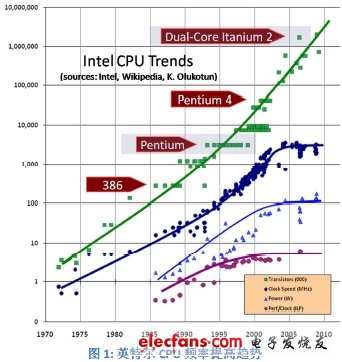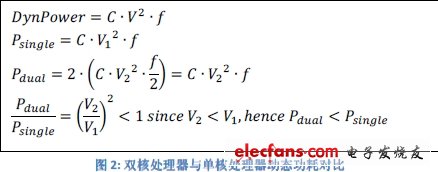This paper discusses and compares the major multi-core processing technologies currently used in mobile platforms, focusing on the synergy between the multi-core processing technology and the breakthrough FD-SOI silicon technology used in the future products of ST-Ericsson, by comparing personal computers. In the market, the single-core processor of the mobile platform has a lot of room for performance improvement. From the perspective of software performance, it is now more profitable to concentrate resources on faster dual-core processors than slower quad-core processors.
In addition, we will discuss how FD-SOI technology can increase dual-core processor frequency under the same power consumption conditions and how to extend the energy-efficient working mode, all of which produce a simpler and more complex than heterogeneous and homogeneous quad-core processors. Cheaper, more efficient solution.
The advent of multi-core processors is inevitable, not an option
Multi-core processors are a necessity for technological development, not humans, and it is important to reiterate this. Historically, when the operating frequency increased to the chip's thermal limit, mainstream PC multi-core processors began to appear. In fact, from the initial integration of silicon technology to 2003-2005, in mainstream computers, the increase in operating frequency and the number of transistors are mainly used to improve the performance of single-core processors (see Figure 1). During this period, the performance improvement of the application software is kept in sync with the development of hardware technology, and the ever-increasing number of old software does not need to be modified, resulting in an unprecedented growth in the computer industry.

Whenever possible, this trend will not change until the chip heats up to the limit. An increase in frequency rather than an increase in the number of transistors is part of the reason why the chip has reached the thermal limit. On this issue, multi-core processors are considered to be the only solution that continuously utilizes an increasing number of transistors while limiting power consumption to a controllable range. Although it is counterintuitive, the power consumption of a single-core processor at a hypothetical frequency is higher than that of a dual-core processor at one-half of the assumed frequency. This is because the higher the processor frequency, the required voltage. The higher, in addition, the dynamic power vs. voltage is squared (Figure 2 shows a simple dynamic power calculation).

Multicore processors do allow hardware integration to follow Moore's Law (the number of transistors doubles every 18 months), and the price paid for this is that software performance improvements are completely compromised. For software, there is no free lunch, as described in a famous paper published in the year [1], since then, in order to continue to effectively apply hardware technology advancements, software developers must adopt parallel and balanced programming. To enable code to be efficiently mapped to multi-core processors. In other words, software needs to be parallelized. Unfortunately, software parallelization is still one of the most serious challenges in the entire computer field, although the initial research and development enthusiasm has not diminished. However, a universal solution with satisfactory efficiency has not been found so far [2]. Many serial applications are not parallelized at all.
This problem is very difficult and has made little progress in the past 10 years. G. Blake et al. presented two important observations in the 2010 paper [3]:
· When dual-core processors come out, the fast response speed experienced by users is the most direct advantage of dual-core processors, but after 10 years, most software, including demanding games, office software, multimedia players and web browsing Or just take advantage of dual-core processors, and only a small amount of application software (video production) can make more efficient use of dual-core processors.
In fact, since the advent of multi-core processors 10 years ago, most PC software has not been parallelized except for a small number of applications. Because of the multitasking operating system and some application software design methods, such as event-driven code for handling asynchronous events such as user interfaces, some parallel processing functions are native, but the balance of these native parallel threads Usually very poor, usually associated with each other, only a few threads can use existing multi-core processors in parallel, but in the end can only play the capabilities of dual-core and below processors.
Software developers choose not to parallelize their code because most PC applications don't have to be parallelized at all, or the cost of parallelization is too high. Some niche markets are exceptions. For example, in some multimedia applications, CAD tools, and certain areas of expertise, software performance is the most differentiated feature of these markets. It is expected that multi-core processors will find their way into video games. As mentioned above, this is actually not the case. One reason is that in recent years, graphics processors (GPUs) have grown faster than multi-core CPUs. Therefore, the return on investment in leveraging the graphics processor is higher, and parallelizing the complex game engine to run on a multi-core CPU is a thankless task.
In other areas, the situation of multi-core processors is not the same. For example, in a network data center, multi-core processors are developing smoothly because of the large amount of parallel workload. In the field of scientific computing, software parallelization has its rationality.
Is the mobile industry the same as the PC industry?
The evolution of smartphone performance is essentially an accelerated and spatio-temporal conversion of desktop computer performance evolution. Apple's evolution is a good example. It's easy to find consistent data for a certain period of time, and Apple can represent most mobile platforms.
Figure 3 shows the Dhrystone MIPS (DMIPS) CPU performance test score, where the data is the data used by ARM to analyze its processor. Similarly, we should convert the test scores into the instruction-level parallel test (ILP) used in the Intel CPU performance test in Figure 1, which tests the efficiency of the CPU architecture regardless of the frequency of the processor. IDMIPS-single represents the relative performance of a single-core processor. The test score is obtained by multiplying the frequency by DMIPS/MHz, and DMIPS-dual is the DMIPS-single multiplied by the highest total of dual-core processors from Apple's iPhone 4S. performance. For software performance analysis, we just quoted the benchmark results in Anandtech's iPhone 5 product review: Sunspider and Browsermark are web browser (Javascript) benchmarks, because they are single-threaded, so you can't test multi-core processors; Geekbench is a multi-threaded benchmarking tool that should reflect the performance benefits of multi-core processors.
We noticed two elements in Figure 3:

1. Architecture efficiency (DMIPS/MHz), frequency and final single core performance (DMIPS-single) are not saturated. On the contrary, there is still a lot of room for improvement. This trend is completely different from the evolution of PC single core processor. The route, the latter apparently reached saturation from the beginning of the year. Therefore, we have come to the conclusion that the mobile application single-core processor is different from the processor, and its performance has not yet reached saturation.
2. We anticipate that software performance is directly proportional to single-core processor performance. In fact, test scores from the iPhone 4S to the iPhone 5, and Browsermark have increased significantly. Both phones are dual-core processors, and both benchmarks are single-threaded, so software performance improvements are independent of multicore processors. The increase in test scores is due to the significant increase in software performance of web browsers, especially the optimization of Javascript. In addition, other hardware is likely to be optimized, for example, to improve the memory subsystem. In contrast, Geekbench is a multi-core thread benchmarking tool, and system software changes have little impact on it. The iPhone 5's Geekbench test scores have improved dramatically, which seems to indicate that multi-core processors have at least played a role, but, surprisingly, we haven't seen the same improvement in performance from single-core to dual-core iPhone 4S. In all cases, all benchmarks, including Geekbench, remain below the theoretical performance peak of dual-core processors. We will provide more software performance improvement data later, but to analyze the test scores of these benchmark tools, we can at least get the following preliminary conclusion: like a PC, software performance improvement is directly proportional to the performance of a single-core processor, while It is also related to application software; it has little or no proportional relationship with the performance of multi-core processors.

A solar cell panel, solar electric panel, photo-voltaic (PV) module, PV panel or solar panel is an assembly of photovoltaic solar cells mounted in a (usually rectangular) frame, and a neatly organised collection of PV panels is called a photovoltaic system or solar array. Solar panels capture sunlight as a source of radiant energy, which is converted into electric energy in the form of direct current (DC) electricity. Arrays of a photovoltaic system can be used to generate solar electricity that supplies electrical equipment directly, or feeds power back into an alternate current (AC) grid via an inverter system.
Solar Panel,200w Folding Solar Panel,Folding Solar Portable Power Station,Sunpower Solar Cell
suzhou whaylan new energy technology co., ltd , https://www.nbwhaylan.com